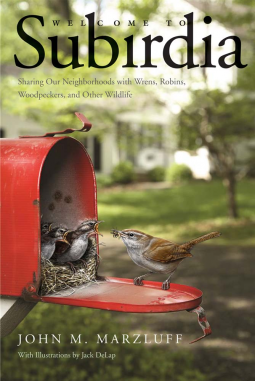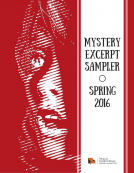
Welcome to Subirdia
Sharing Our Neighborhoods with Wrens, Robins, Woodpeckers, and Other Wildlife
by John M. Marzluff
This title was previously available on NetGalley and is now archived.
Send NetGalley books directly to your Kindle or Kindle app
1
To read on a Kindle or Kindle app, please add kindle@netgalley.com as an approved email address to receive files in your Amazon account. Click here for step-by-step instructions.
2
Also find your Kindle email address within your Amazon account, and enter it here.
Pub Date Sep 30 2014 | Archive Date Sep 21 2014
Description
Over many years of research and fieldwork, Marzluff and student assistants have closely followed the lives of thousands of tagged birds seeking food, mates, and shelter in cities and surrounding areas. From tiny Pacific wrens to grand pileated woodpeckers, diverse species now compatibly share human surroundings. By practicing careful stewardship with the biological riches in our cities and towns, Marzluff explains, we can foster a new relationship between humans and other living creatures—one that honors and enhances our mutual destiny.
A Note From the Publisher
Advance Praise
“John Marzluff writes with authority and insight about the lives and habits of birds around us and suggests steps we can take to protect them in an increasingly hostile world.”—Peter Doherty, Nobel Laureate and author of Their Fate is Our Fate: How Birds Foretell Threats to Our Health and Our World
“Suburbs are increasingly an important factor affecting wildlife, especially birds--both negatively and positively. There is much that we can do for animals as ‘good neighbors’ that enriches their lives and ours. Nobody is more well-suited and qualified than John Marzluff to address this issue.”—Bernd Heinrich, author of The Homing Instinct: Meaning and Mystery in Animal Migration, Life Everlasting: The Animal Way of Death, and Mind of the Raven
“I know of no other book that covers this topic. The synthesis is novel and powerful. . . . This is a unique, interesting, and important work.”—Steward Pickett, Cary Institute of Ecosystem Studies
“A triumph! Everything you wanted to know about suburban birds—and more.”—Tim Birkhead, author of Bird Sense and Ten Thousand Birds: Ornithology since Darwin
“With enthusiasm, wit, and compelling scholarship, John Marzluff challenges us to reconsider a forgotten landscape. Welcome to Suburdia is more than entertaining—it will change the way you think about cities, nature, and your own backyard.”—Thor Hanson, author of Feathers: The Evolution of a Natural Miracle
“What is a scientist to do when he discovers that he's seen more bird species in New York's Central Park than he did in Yellowstone? Study the phenomenon, of course. Marzluff's exploration of this seeming paradox leads him to "subirdia"—that edgy place between suburbs and wilderness. If you love nature, but feel guilty about owning a plot in the "burbs," or being a city denizen, take heart. Birds—and other wild creatures—are doing better there than most of us think, Marzluff reveals in this engaging and beautifully written book. You'll come away, too, with a bird's appreciation of your own backyard. That (unmowed) lawn is a savannah! Those parkway trees, a forest. The birdbath, a pond. We haven't lost the birds and animals; we've brought them to us. Marzluff's book shines with insights and revelations into a natural world many of us live in but fail to see: Our own backyards.”—Virginia Morell, author of Animal Wise: How We Know Animals Think and Feel
“John Marzluff has combined his experiences as an ornithologist, urban ecologist, and observer of nature into a very readable book about birds, humans, and our linked fates in a rapidly changing world.”—Stephen DeStefano, author of Coyote at the Kitchen Door: Living with Wildlife in Suburbia
Marketing Plan
A conversation with John M. Marzluff:
Q: You started your research studying crows, jays, and ravens. What was the catalyst for making the transition to birds and wildlife in urban areas?
A: Moving to Seattle in the late 1990s, I was confronted with a rapidly growing urban area that was spilling into relatively wild country. When a large forest near my home became a high-end subdivision, I knew I had to take a closer look. Researching how birds and other wildlife responded to development was a perfect way to combine my love of pure science with my desire to offer planners, developers, and others relevant ecological knowledge.
Q: The research you and your students and postdocs undertake requires many patient and persistent observers. About how many have contributed to your research in subirdia and for how long?
A: To understand the ups and downs of bird populations and the natural booms and busts of birth and death requires a decade or more of standardized measurement. For thirteen years, teams of eight to ten of us (including undergraduates, doctoral students, postdocs, master’s candidates, and interns) took to the woods and streets every spring and summer.
Q: What do you hope readers will take away from their experience of encountering Welcome to Subirdia?
A: A better understanding of and appreciation for the ecosystem we call “home” and the tools needed to nurture a life enriched by our wild neighbors.
Available Editions
| EDITION | Hardcover |
| ISBN | 9780300197075 |
| PRICE | $30.00 (USD) |














